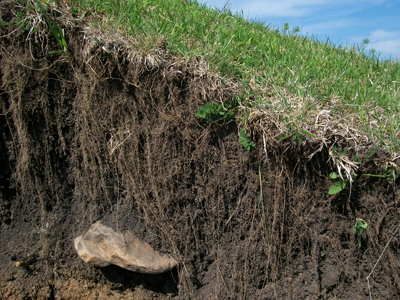Here is a really good introduction to the use of the on-line Soil Survey from USDA. Maybe it is easier to follow than blogs I have posted in the past.
WASHINGTON — “Soil don't get no respect,” Rodney Dangerfield might have said (but didn't). Perhaps you know your state bird or flower, but do you know your state soil?
Well, in recent years soil has begun to get more respect. Since the celebration of the Soil Survey Centennial back in 1999, each state has been given its own official state soil. It was in 1899 that the U. S. Department of Agriculture started its survey of all the soils in the country.
SOILS COME IN MANY ‘Flavours'
You might wonder what a “soil survey” really is. Isn't it all just dirt — some perhaps stickier, or redder or deeper — that lies beneath forest, meadow, farm, home and garden?
There you go again. Not enough respect.
In fact, soils are distinctive, as different from each other as robins are from blue jays. These differences are hard to appreciate, of course, because soil is mostly underground, hidden from view. But if you were to dig some holes a few feet deep and then look carefully at their inside surfaces, you would find that soils are made up of layers of varying thickness, called horizons. One soil might differ from the next not only in the thickness of its horizons, but also in their appearance and feel.
Horizons might be as white as chalk, as red as rust, or as dark brown as chocolate. A horizon might be cement-hard, gritty with sand, or stuff for sculpture. And if you were to tease the dirt along one edge of the hole so it falls away naturally — wow! — each horizon would reveal its particles clumped together in arrangements like plates, blocks or prisms. Such information, and more, has allowed soils to be classified, much as birds, flowers and other living things are.
CLASSIFYING SOILS
Modern soil classification goes back only a few decades, when all the world's soils were grouped taxonomically into a dozen “orders.” Differences among orders reflect the formative influence of a particular combination of climate, plants and animals, topography, time and original rock material.
Just as all vertebrate animals are huddled together by biologists into smaller groupings (mammals, say) and those groupings into still smaller ones, so each soil order is divided and subdivided to include more distinctly different soils. At the end of the dividing and subdividing, you end up with a “soil series” identified with a proper name — like the Haven series in my vegetable garden, for example.
YOUR STATE'S AND BACKYARD'S SOIL
A particular soil becomes an official state soil by being widespread within the state; being distinctive chemically or physically; having some degree of name recognition; and, of course, getting a legislative stamp of approval. Examples include soils like West Virginia's Monongahela soil, Texas' Houston Black soil, California's San Joaquin soil and New York's Honeoye soil.
The job, now, of these “ambassadors” of the benevolent underworld is to rekindle awareness of soil's value as a natural resource that can only be renewed very slowly. Soil provides food, shelter, clothing and more, yet it is being lost at alarming rates to everything from blacktop to erosion.
Out in the garden this spring, dig a hole deep and wide enough that you can see and appreciate at least some of the various and distinctive horizons.
Then, if you want the name and a detailed description of that soil — or any soil — look at the maps and descriptions in the Soil Survey Reports issued by the U. S. Department of Agriculture, Natural Resource Conservation Service (NRCS). Search online for “soil survey nrcs” and you'll find links to soil maps for counties throughout the U.S. Or go to the link to “web soil survey.” At this site, you can type in a street address around which you “draw” your area of interest (AOI). The site will delineate the names and descriptions of soils within that AOI.
And of course this is available as an app at:
https://casoilresource.lawr.ucdavis.edu/soilweb-apps/
Online:
www.leereich.com/blog
leereich.com
http://www.leereich.com/2016/06/edens-gardens.html
Attached Images:
